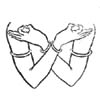Samyuta Hastas. Double Hands Gestures
SHLOKA:
ANJALISCHA KAPOTASCHA
KARKATAH SWASTIKASTATHA
KATAKAVARDHAMANASCHA
UTSANGO NISHEDHASTATHA
DOLA PUSHPAPUTASCHAIVA
TATHA MAKARA EVA CHA
GAJADANTO VAHITTASCHA
VARDHAMANASTATHIVA CHA
ETE TU SAMYUTA HASTA MAYA
PROKTASTRAYODASHA
According to Natyashastra there are 13 types of Samyuta Hastas:
1. ANJALI
 PUNASCHA
SAMYUTAN HASTAN PUNASCHA
SAMYUTAN HASTAN
GADATO ME NIBODHATA
PATAKABHYAM TU HASTABHYAM
SAMSLESHADANJALI SMRUTAHA
Meaning: If two palms in the Pataka position are joined together, it is the
Anjali hasta.
Usages: This hasta is used for greetings and is held above the head to greet
Gods, it is held between brows to greet Gurus and in front of the chest to greet
Brahmins and scholars.
2. KAPOTA
 UBHABHYAMAPI
HASTABHYAM UBHABHYAMAPI
HASTABHYAM
ANYONYAN PARSHVA SANGRAHAT
HASTAH KAPOTAKO NAMA KARMA
CHASYA NIBODHATA
Meaning: When two hands in the Anjali position are folded as if holding a dove,
it is the Kapota hasta.
Usages: salutation, agreement; to show fear, cold.
3. KARKATA
 ANGULYO
YASYA HASTASYA ANGULYO
YASYA HASTASYA
ANYONYANTARANI SMRUTAHA
SA KARKATA ITI GNEYAHA KARAH
KARMA CHA VAKSYATE
Meaning: When the fingers of two hands are stretched out and intersected, it is
the Karkata hasta.
Usages: bee's wax, massaging of arm or leg, yawning after awakening, supporting
the chin, pulling down a branch.
4. SWASTIKA
 MANIBANDHANAVINYASTAU MANIBANDHANAVINYASTAU
ARALOU VARDHAMANAKAU
UTTANAU VAMAPARSHVASTAU
SWASTIKA PARIKEERTITAHA
Meaning: When two hands in the Arala position are crossed vertically at the
wrist and are shifted to the left, it is the Swastika hasta.
Usages: clouds, the sky, forests, sea, seasons, the earth.
5. KATAKA VARDHAMANAKA
 KATAKA
KATAKAIRNYASTAHA KATAKA
KATAKAIRNYASTAHA
KATAKAU VARMANAKAHA
SHRINGARARTHESHU YOKTAVYAHA
PRAMANAKARANE TATHA
Meaning: When two hands in the Katakamukha position are crossed at the wrist, it
is the Kataka Vardhamanaka hasta.
Usages: to show Shringara (rasa "Erotica"), bowing down to person.
6. UTSANGA
 ARALAU
TU VIPARYASTAU ARALAU
TU VIPARYASTAU
UTTANAVURDHVANATAU
UTSANGA ITI VIGNEYAHA
SPARSHASYA GRAHANE KARAHA
Meaning: When two hands in the Arala position are crossed and lifted up towards
forearms, it is the Utsanga hasta.
Usages: feeling of touch, anger, jealousy.
7. NISHADHA
 SA
CHAPI DAKSHINO HASTAHA SA
CHAPI DAKSHINO HASTAHA
SAMYAND MUSHTIKRITO BHAVET
ITYESHA NISHADHO HASTAHA
KARMA CHASYA NIBODHATA
Meaning: When the left hand of the Mukula hasta is covered by the right hand of
the Mushti hasta, it is the Nishadha hasta.
Usages: patience, intoxication, arrogance.
8. DOLA
 AMSAUPRASHITHILAU
MUKTAU AMSAUPRASHITHILAU
MUKTAU
PATAKAU PRAVILAMVITAU
YADYA BHAVETAM KARANE SA DOLA
ITI SMRUTAHA
Meaning: When both shoulders are released and both hands in the Pataka position
are lowered along the body line, this is called the Dola hasta.
Usages: weakness, darkness, faint, idleness, passionate love.
9. PUSHPAPUTA
 YASTU
SARPASIRAH PROKTAHA YASTU
SARPASIRAH PROKTAHA
TASYANGULI NIRANTARAHA
DVITYAH PARSHVASUSLISHTAHA
SA TU PUSHPAPUTA SMRUTAHA
Meaning: When two hands in the Sarpasirsha position are closely pressed to each
other, it is called the Pushpaputa hasta.
Usages: to show the receiving or carrying of rice, fruit, flowers and the taking
or removing of water.
10. MAKARA
 PATAKAU
TU YADA HASTAU PATAKAU
TU YADA HASTAU
MURDHVANGUSHTAVADHO MUKHAU
UPARYUPARI VINYASTAU TADA
SA MAKARA KARAHA
Meaning: When the palms of two hands in the Pataka position are turned downwards
and placed one over the other with the thumbs lifted, it is called the Makara
hasta.
Usages: fish, crocodile.
11. GAJADANTO
 KURPARASANCHITAU
HASTAU KURPARASANCHITAU
HASTAU
YADASTANAM SARPASIRSHAKAU
GAJADANTAH SA VIGNEYAHA
KARMA CHASA NIBODHATA
Meaning: When two hands in the Sarpasirsha position are placed on the forearms,
it is called the Gajadanto hasta.
Usages: the bride and the groom, excessive weight, embracing a pillar.
12. AVAHITTA
 SHUKATUNDAU
KARAU KRUTVA SHUKATUNDAU
KARAU KRUTVA
VAKSHASYABHIMUKHANCHITAU
SANAIRADHOMUKHAVIDHAU
SOVAHITTA ITI SMRUTAHA
Meaning: When two hands in the Shukatunda position meet each other on the chest
with palms turned upwards and the palms are turning slowly over downwards, it is
called the Avahitta hasta.
Usages: weakness, to sigh, to find somebody.
13. VARDHAMANA
 VIGNEYO
VARDHAMANASTU VIGNEYO
VARDHAMANASTU
HAMSAPAKSHAHU PARANMUKHAU
JALAVATAYANADINAM
PRAYOKTAVYO VIGHATONE
Meaning: When two hands in the Hamsapaksha position are crossed at the wrist, it
is called the Vardhamana hasta.
Usages: opening the windows, doors etc.
| 